
The Carcassonne history is a story of how a simple yet brilliant design turned a medieval-themed tile game into one of the most iconic board games of all time. Released in 2000 by Klaus-Jürgen Wrede, Carcassonne has become synonymous with tile placement games, inspiring countless designers and introducing millions of players to modern tabletop gaming.
The Inspiration Behind Carcassonne
The game draws inspiration from the real-world medieval fortress city of Carcassonne in southern France. Known for its walled cities, winding roads, and scenic fields, Carcassonne provided the perfect thematic backdrop for a map-building game.

Wrede envisioned a game where players gradually construct the landscape, placing tiles one by one, building cities, roads, monasteries, and farms. By keeping the rules simple yet allowing for strategic depth, Carcassonne struck a perfect balance between casual gameplay and tactical decision-making.
How Carcassonne Defined Tile Placement Games
Before Carcassonne, tile placement mechanics existed but were rarely the core gameplay focus. Games like Tigris & Euphrates used tiles for conflict resolution, while RoboRally employed tiles for movement planning. However, Carcassonne introduced a system where every tile placement mattered, shaping both the shared map and each player’s scoring opportunities.
The game’s key innovation was the introduction of meeples, wooden figures players could place on features like cities, roads, and fields. These meeples became iconic, eventually becoming the unofficial mascot of modern board gaming.
Expansions and Continued Popularity
The Carcassonne history is also a story of constant evolution. Over the years, dozens of expansions have introduced new mechanics, including rivers, traders, builders, catapults, and even dragons. While some expansions increased complexity, the core gameplay always remained intuitive and welcoming.
Carcassonne’s accessibility, combined with endless replayability, helped it win the prestigious Spiel des Jahres award in 2001. This recognition propelled it to international fame, ensuring its place in board game collections around the world.

Carcassonne’s Influence on Modern Game Design
The Carcassonne history extends beyond its own franchise. It directly influenced the evolution of tile placement games like Isle of Skye, Kingdomino, and Suburbia. Its modular board system also inspired legacy games and map-building mechanics across multiple genres.
Thanks to its easy-to-learn gameplay, strategic depth, and endless expansion options, Carcassonne remains a gateway game, introducing new players to modern board gaming every year.
Conclusion
The Carcassonne history demonstrates how a simple idea — building a map together — can revolutionize a genre. By combining tile placement, area control, and iconic meeples, Carcassonne has cemented its legacy as both a modern classic and the benchmark for tile placement games.
Featured Image – Carcassonne Game In Progress BoardGameGeek




